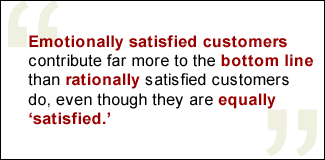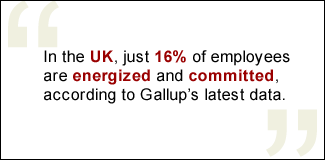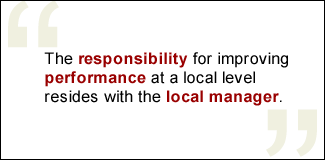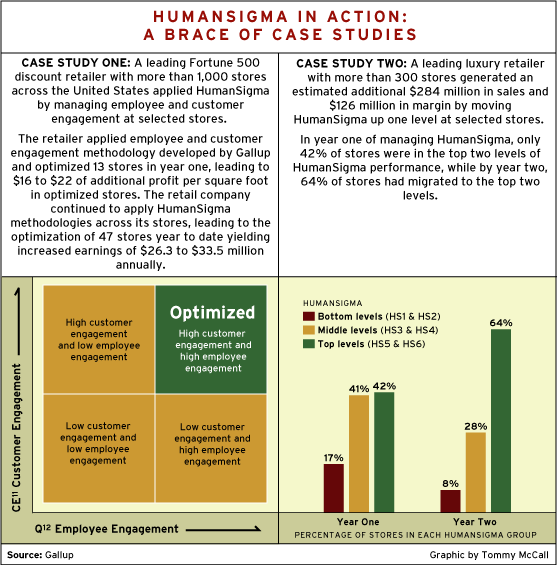When Motorola, Inc. introduced the concept of Six Sigma in the mid-1980s, a new business process-improvement movement was born. Six Sigma integrated a metric to count quality defects with a disciplined process to eliminate them. It galvanized business management and spearheaded the Total Quality Management movement.
Quality improvement methodologies such as Six Sigma are extremely useful in manufacturing contexts, where components with predictable properties are repeatedly combined in the same way, but they are less useful when it comes to the employee-customer encounter, with its volatile human dimension.
 |
HumanSigma addresses this problem of fit. Like Six Sigma, HumanSigma focuses on reducing variability and improving performance. However, it also looks at the quality of the employee-customer encounter -- providing a consistent method for assessing it and a disciplined process for managing and improving it.
How do you measure quality?
Measuring quality within the confines of a product is easy. Does it work? Does it look good? Does it last? Measuring quality within non-manufacturing environments -- sales and services companies -- is more complex. The question is, where is value created? In sales and service organizations, the employee-customer encounter could be the call center, the showroom, or the storefront, where value is created (or destroyed). Businesses need therefore to manage that relationship with care in order to guard and drive financial performance and growth.
Six Sigma is analytical and data driven, abiding by certain parameters and functional requirements. Humans, however, are not so rational and easy to pin down! People base their decisions on a complicated mixture of emotion and reason. In fact, recent work in neuroscience and behavioral economics suggests that emotions may play a larger role than rational analysis.
|
HUMANSIGMA: FOUR KEY PRINCIPLES Here is a summary of the four core principles of HumanSigma used to measure and manage interactions between customers and employees:
|
Emotionally satisfied customers contribute far more to the bottom line than rationally satisfied customers do, even though they are equally "satisfied." Gallup's research suggests that for all kinds of companies, fully engaged customers -- those who score in roughly the upper 15-20% on Gallup's measure of emotional engagement -- deliver a 23% premium over the average customer in terms of share of wallet, profitability, revenue, and relationship growth. Without the emotional component, customer ratings often cause extreme confusion. Moreover, Gallup research has shown that rationally satisfied customers often look and behave no differently than rationally dissatisfied customers!
To arrive at a single measure of effectiveness for the employee-customer encounter that has a high correlation with financial performance, HumanSigma must take emotion into account. Measuring customer engagement combines traditional metrics of customer loyalty (overall satisfaction, likelihood to repurchase, and likelihood to recommend) with an assessment of customers' emotional commitment:
- Confidence in the company and its ability to deliver on promises
- Integrity in the way the company treats the individual
- Pride, and whether the customer positively identifies with the company
- Passion -- where a company is irreplaceable in that customer's life -- a rare, but priceless customer
Local encounters are the key
Every and any interaction with a customer -- such as a new sales opportunity or complaint handling -- is a chance to develop a relationship and build an emotional connection.
In the UK, just 16% of employees are energized and committed, according to Gallup's latest data. Distressingly, 60% of workers can be classified as ROAD warriors -- Retired on Active Duty -- those who show up and do what is expected, but no more. (See "Great Britain's Workforce Lacks Inspiration" and "Start Worrying About 'Not Engaged' Employees" in the "See Also" area on this page.) Contrast this with engaged staff, who are consistently more productive at work, have higher safety records and levels of attendance, and stay longer, reducing training and replacement expenses. Moreover, through providing consistently great customer service, they also enhance referral and return visit rates. It's a key strategy for growing a business organically.
 |
Employee engagement, at an emotional level, is as crucial to the success of a business as customer engagement. How to measure engagement and deciding what metrics to use is the first step in effectively managing the customer-employee relationship within HumanSigma. However, deciding how to deploy these metrics will also have a huge impact on the success of any initiative.
The leadership team needs to set the right tone, but local variability is the critical issue, and the only way to improve local performance is to provide feedback and implement action at the local level. Consider how a customer who is routinely faced with appalling service, or an employee whose local workplace is miserable, feels when claims such as "a world leader in service excellence" or "a fun place to work" are touted. When the employee-customer encounter is assessed at the level of a local workgroup, the executive team can learn a lot about their company's performance.
While it is natural to see some local variation, factors such as shop size, location, age, or locale cannot be "blamed" for performance outcome every time. For every location, there is a different customer experience, and in part a different "brand" or culture of that company in existence. To reduce variability in the customer experience, and hence [increase] the success of the business, organizations should focus on reducing the variability in local people processes, where the power of a local focus lies in each unit's ability to identify and correct its own problems.
Deploying HumanSigma
In summary, responsibility for the employee-customer relationship must be centralized. Employee and customer engagement are intimately connected, and together, they have an outsized effect on financial performance; therefore, [they] must be managed holistically. The leadership team should be held accountable for the quality and financial return, and management needs to be consistent and agree on what behavior is acceptable. In practical terms, this means that organizations need a HumanSigma champion at the executive level who has the authority to initiate and manage change.
However, the responsibility for improving performance at a local level resides with the local manager. Gallup research suggests that people join great companies but leave poor managers. People's working life revolves around their local environment and the people they work with on a day-to-day basis. The relationship with their local manager is essential in driving employee engagement. Both staff and their managers can use the same techniques, from training or coaching to performance reviews, to develop and ensure support.
 |
In putting HumanSigma into practice, some companies will need to take a close look at their HR system and any changes that are required. If regional variation continues to be an issue, for example, a company might want to look at changing its methods of recruitment, performance and appraisal, or staff reward and promotion, for example.
Bottom-line results
Having developed HumanSigma based on years of research into the customer-employee encounter, Gallup has seen impressive results from the organizations employing the best-practice principles. Ten partner companies, across financial services, professional services, retail, and sales, together outperformed their five largest peers during 2003 by 26% in gross margins and by 85% in sales growth. The results are strong evidence that monitoring the health of a firm's employee-customer relationships can lead to dramatic performance improvements.
Managing the performance variation in workgroups can raise overall performance by orders of magnitude and can create organic growth. The potential for improving financial performance resides within a company's human performance -- its customers and employees. The value of the customer-employee encounter, and the need to manage that human process, is of supreme importance and should be on every CEO's agenda.
 |
Reprinted with permission from Customer Management. Customer Management is a publication of Quest Media Limited.